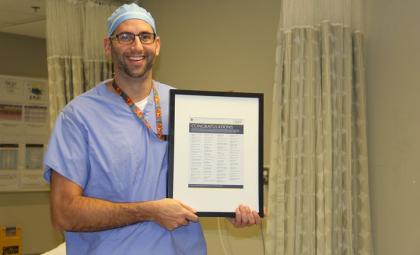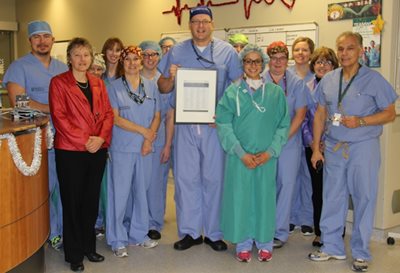A ‘Meritorious’ achievement

PETERBOROUGH REGIONAL HEALTH CENTRE RECOGNIZED FOR SURGICAL SAFETY OUTCOMES
Monday, January 15, 2018 – Christine Smith
For Peterborough Regional Health Centre (PRHC), committing to quality improvement is a marathon not a sprint. That approach has earned the Centre a spot as one of only 66 international hospitals deemed “Meritorious” by the American College of Surgeons for its surgical safety outcomes. Of hospitals that earned this distinction, only eight are Canadian.
The College based its recognition on Peterborough’s 2016 surgical quality composite score in the National Surgical Quality Improvement Program (NSQIP). That puts PRHC in good company – Sunnybrook Health Sciences, Mount Sinai Hospital, the Cleveland Clinic and Johns Hopkins also earned the meritorious distinction.
MEANINGFUL CHANGE
The road leading to this outcome wasn’t short or easy. The work began in 2014 and by 2015, PRHC had been chosen as one of only 15 Ontario hospitals to participate in the NSQIP program. Today there are 29 Ontario hospitals participating in the NSQIP, which is currently used in nearly 800 adult and pediatric hospitals internationally.
“For us,” says vascular surgeon Dr. Justin Clouthier, lead physician of the program, “we saw the program as an opportunity to pursue best practices.” Clouthier replaced Dr. Lynn Mikula, acting surgeon and Chair of PRHC’s Medical Advisory Committee, who was the surgeon champion for the program when it was implemented in 2015.
 He credits the hospital’s team of more than 30 surgical and clinical staff, along with IT experts and managers, for committing to this quality improve process.
He credits the hospital’s team of more than 30 surgical and clinical staff, along with IT experts and managers, for committing to this quality improve process.
Dr. Clouthier enthusiastically endorses the NSQIP for its ability to produce “robust” data from thousands of patients and procedures. Some of the procedures they measure include mortality, cardiac failure, respiratory issues, surgical site infections (SSIs), and kidney failure either during or after surgery.
Because the NSQIP data is cross-matched and crossed-referenced, it results in quantifiable benchmarks to measure outcomes against. “When physicians see the numbers and the targets, they want to hit them. Knowing the benchmarks from the outset allows you to strive for them,” he says.
Because the NSQIP data is cross-matched and crossed-referenced, it results in quantifiable benchmarks to measure outcomes against. “When physicians see the numbers and the targets, they want to hit them. Knowing the benchmarks from the outset allows you to strive for them,” he says.
While the goal of the NSQIP is to reduce surgical morbidity and apply what’s known as “best scientific evidence” to the practice of surgery, Dr. Clouthier and his team experienced an added benefit. “It is great to be part of a program that actually results in meaningful change,” he says. “It not only affects patient outcomes, and the quality of surgical procedures they receive, but it’s actually doing something positive – something that’s making a positive difference in patient safety and care.”
HOW THEY DID IT
To improve surgical quality and safety, create faster recovery times and shorter hospital stays, PRHC has invested in technology and equipment to perform more minimally invasive general surgeries. Of almost 22,000 surgeries at PRHC in 2016, 40 per cent were minimally invasive, and the hospital has set a goal of 80 per cent.
PRHC also adopted some of the operating room procedures that are part of the NSQIP strategy, including: standardizing how surgeons make their cuts and how they close; making sure patients receive pre-operative antibiotics; having the proper dressings applied; and ensuring patients are warm so their ability to fight off infection is higher.
“THIS IS A MARATHON”
Dr. Clouthier points out that improving surgical quality and safety outcomes at PRHC is an ongoing process. “This is a marathon,” he says. “What you do is constantly strive for low SSIs, low pneumonias, low kidney failures. You always look at implementing new ways to improve and minimize complications. It’s something that never really stops.”
He also has some advice for other hospitals striving to meet the NSQIP benchmarks: take a multi-disciplinary team approach. “Get input from everyone. There are different challenges, outlooks, jobs and specialities and all will have opinions on an issue. You want to make sure you’re doing the right thing to make changes that are feasible and efficient. The team approach is most important.”
BACKED BY RESEARCH
As part of the Canadian Patient Safety Institute’s (CPSI) Surgical Care Safety Action Plan, the Canadian Medical Protective Association (CMPA) and HIROC collaborated in the retrospective analysis of 3,074 in-hospital surgical medical legal cases arising between 2004 and 2013.
They found that almost two-thirds of the cases involved non-trauma/non-oncology repairs or excisions (e.g. inflammations or infections.) Twelve per cent of the CMPA and 18 per cent of HIROC’s surgical incidents related to surgical never events such as retained foreign bodies or wrong surgeries. Other findings from the joint analysis:
- the most common system issues include inadequate, lack of or non-adherence with a surgical safety protocol such as a surgical safety checklist;
- severe patient outcomes, including death and catastrophic harm, were identified in 32 per cent of CMPA and 39 per cent of HIROC surgical incidents;
- the most incidents occurred during the intra-operative phase.
For more information on HIROC and CMPA’s findings, refer to Safety is a shared responsibility: a 10-year review of surgical safety incidents in Canada.
To learn how to minimize your risk, review HIROC’s Risk Reference Sheets on Wrong Patient/Site/Procedure, Unnecessary/Obsolete Procedures and Retained Surgical Items.
To learn more about the NSQIP go to the American College of Surgeons National Surgical Quality Improvement Program.
Christine Smith is a freelance writer based in Toronto